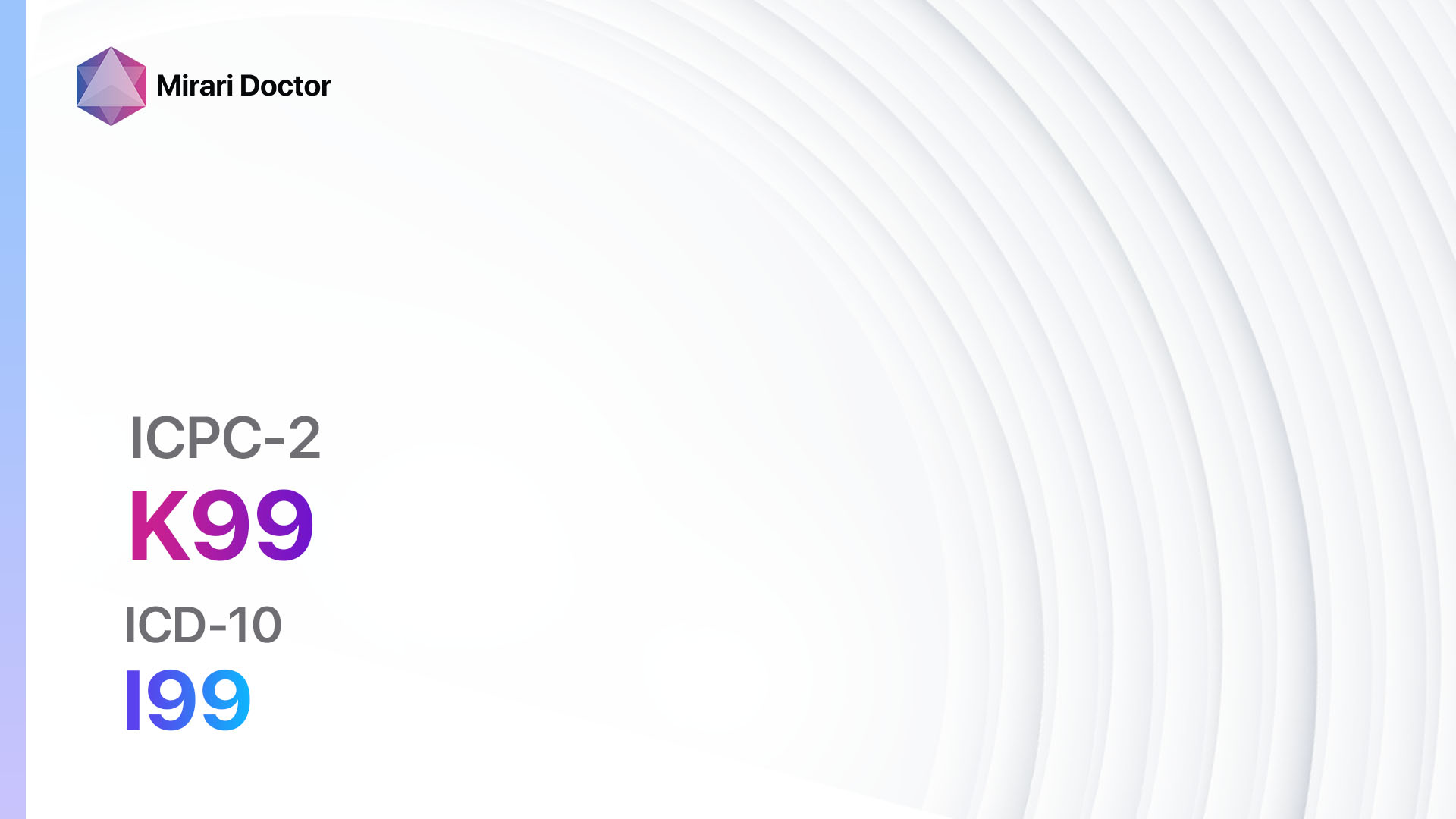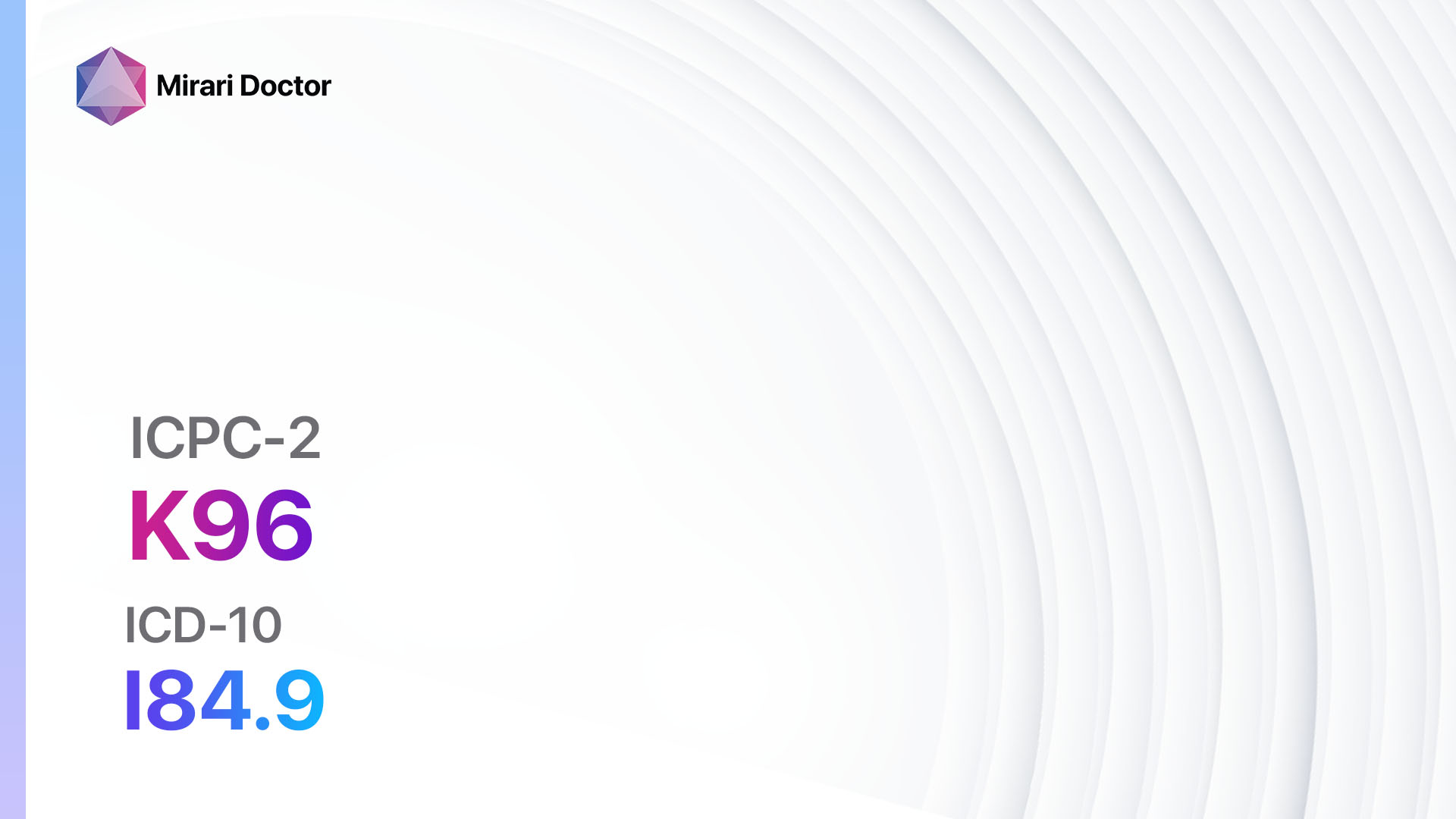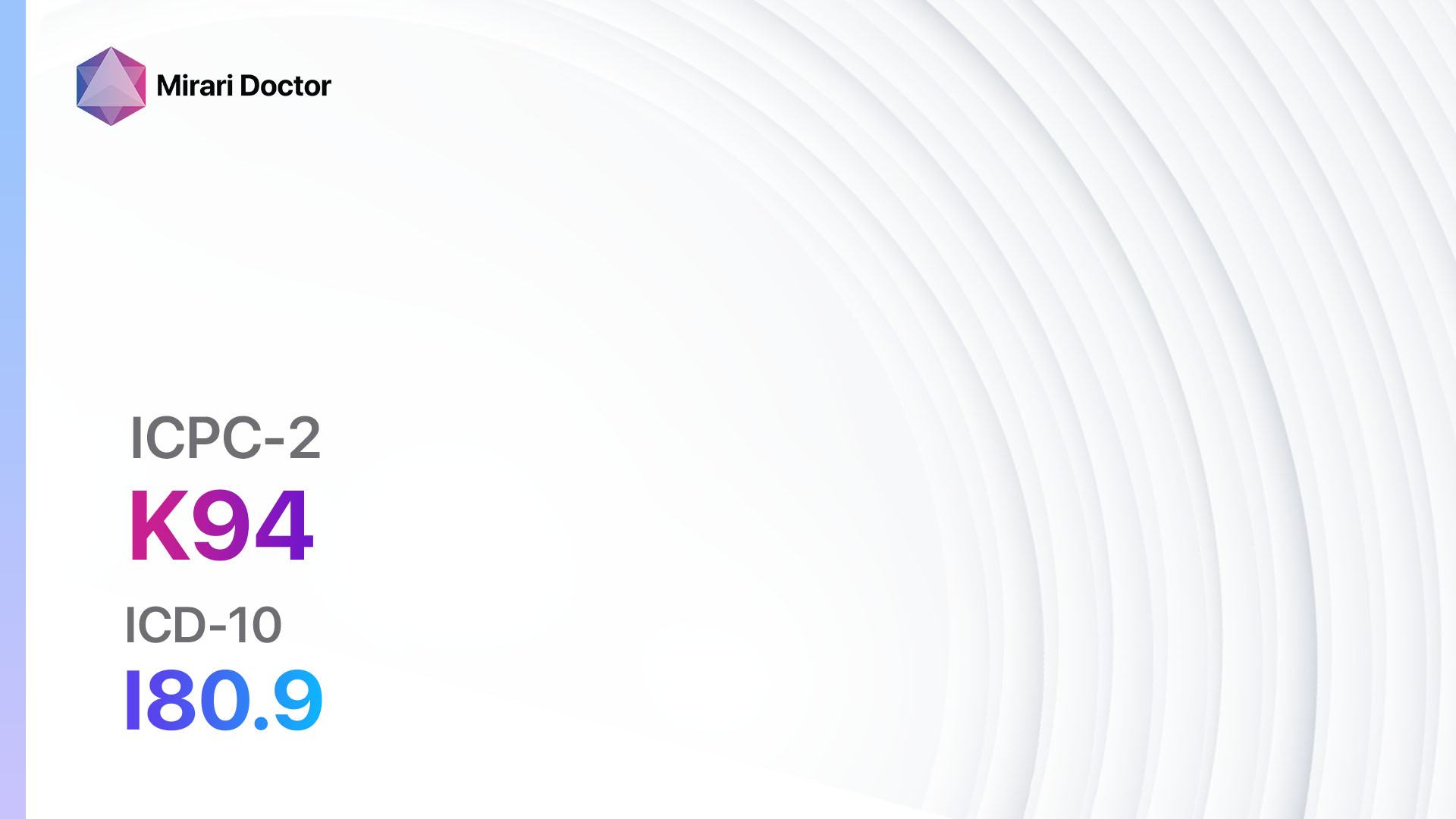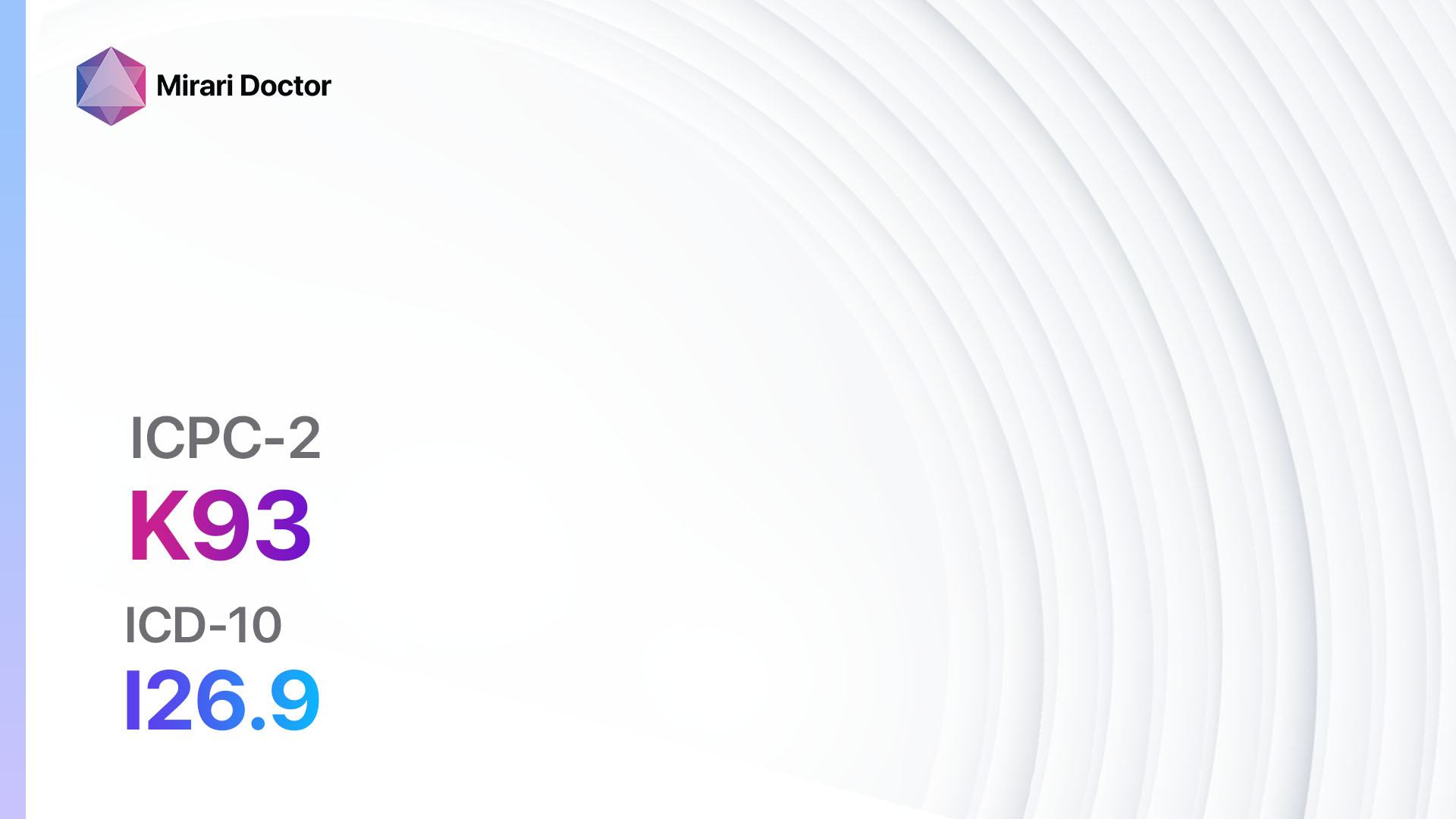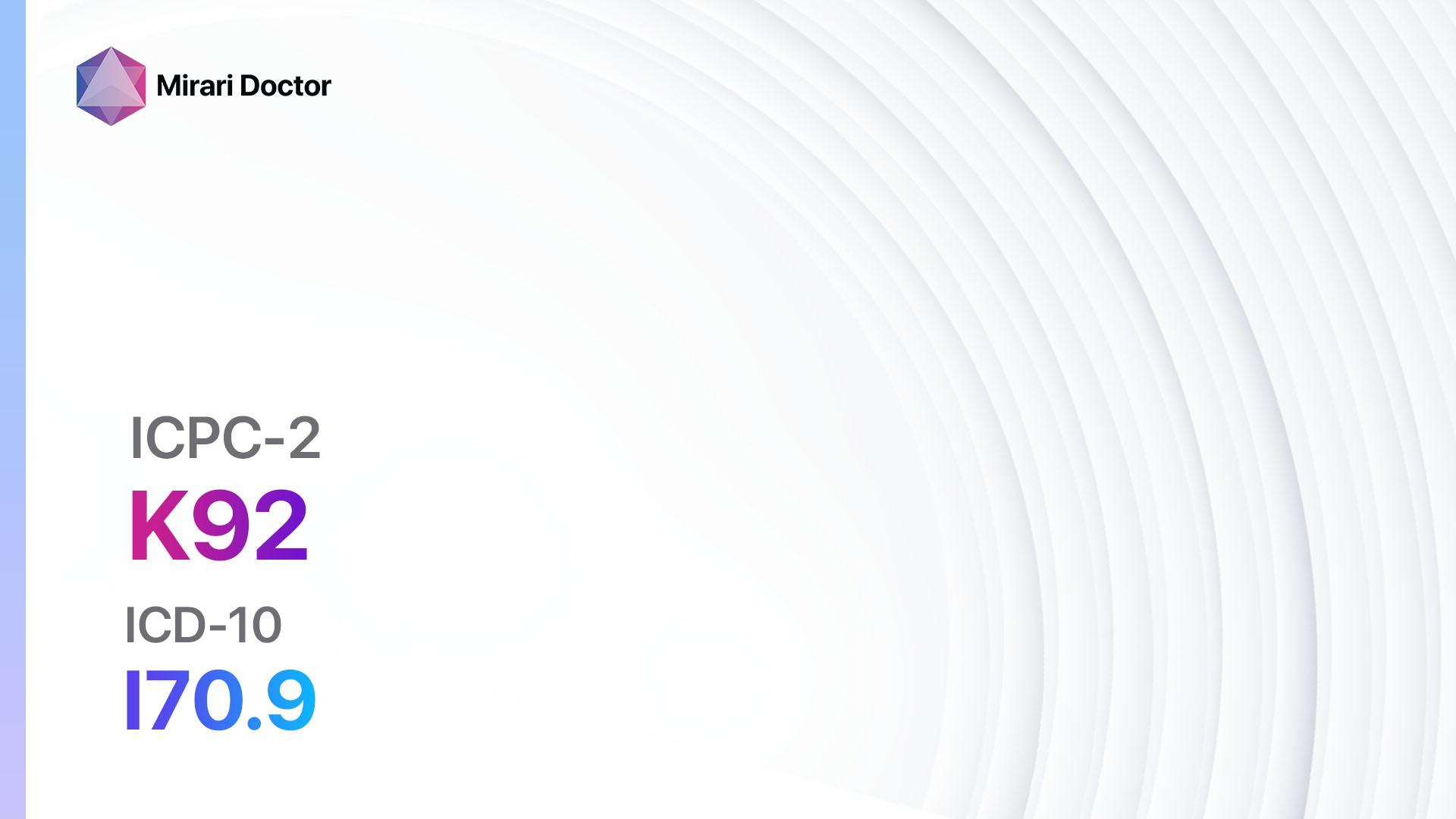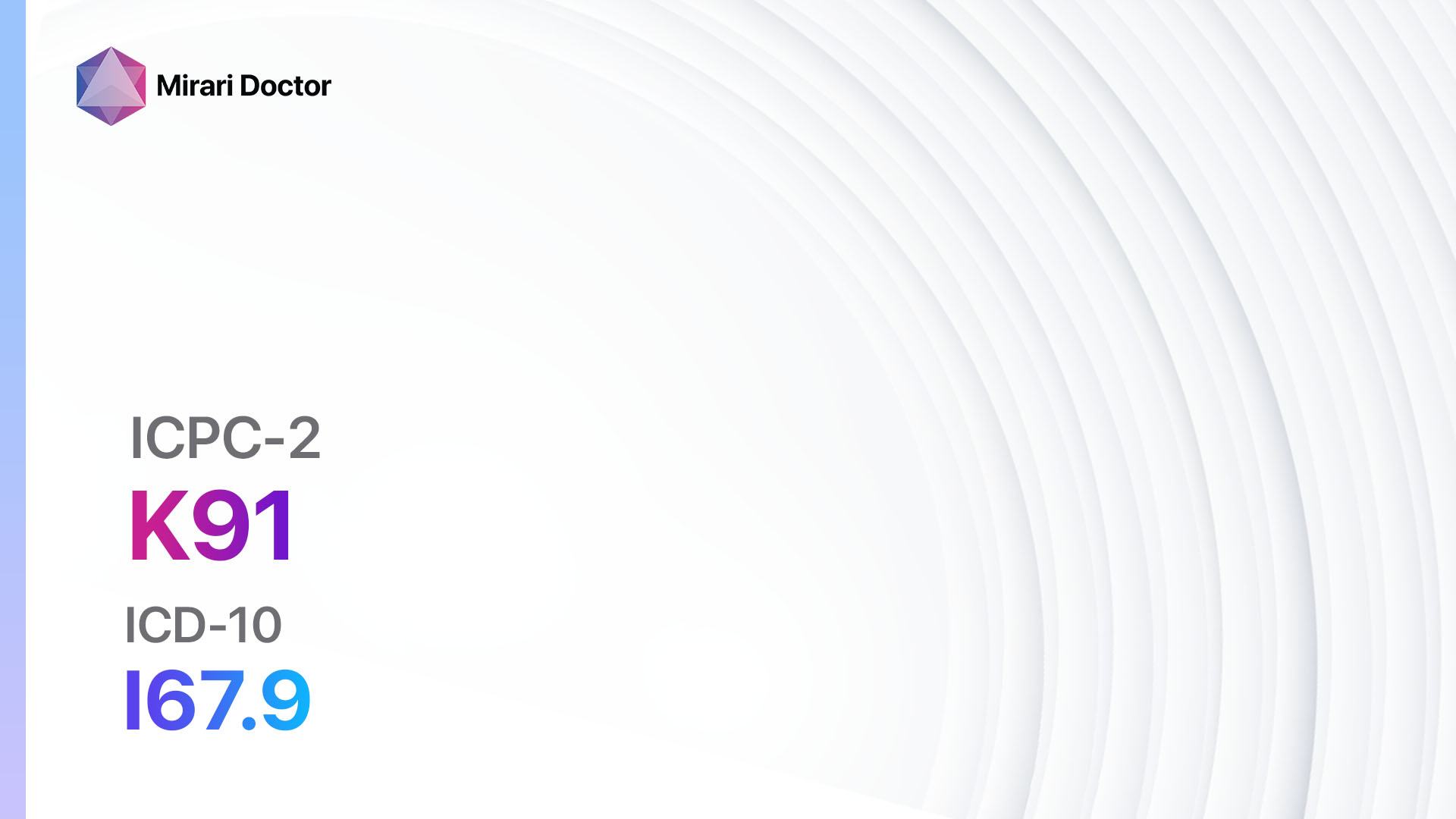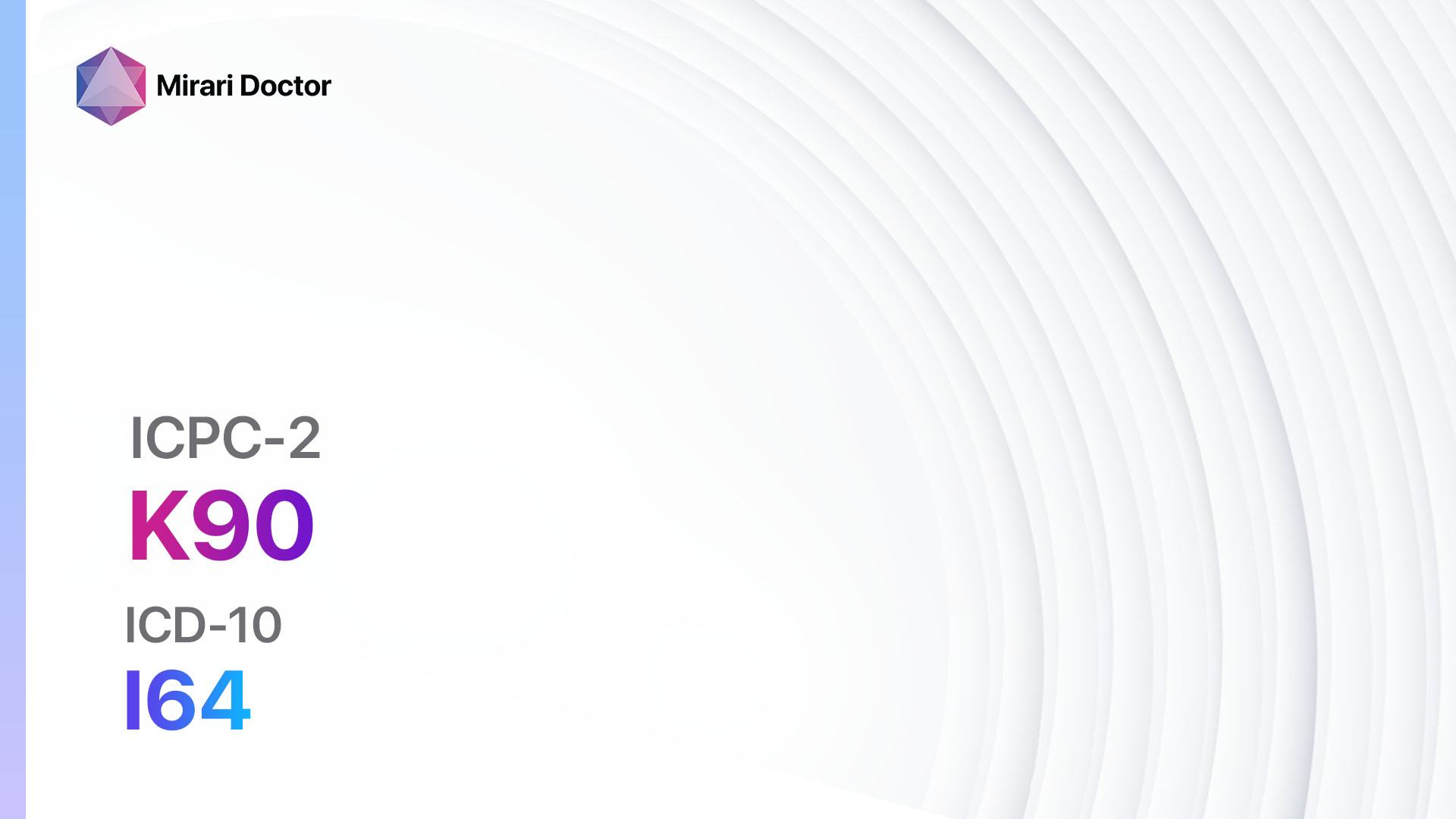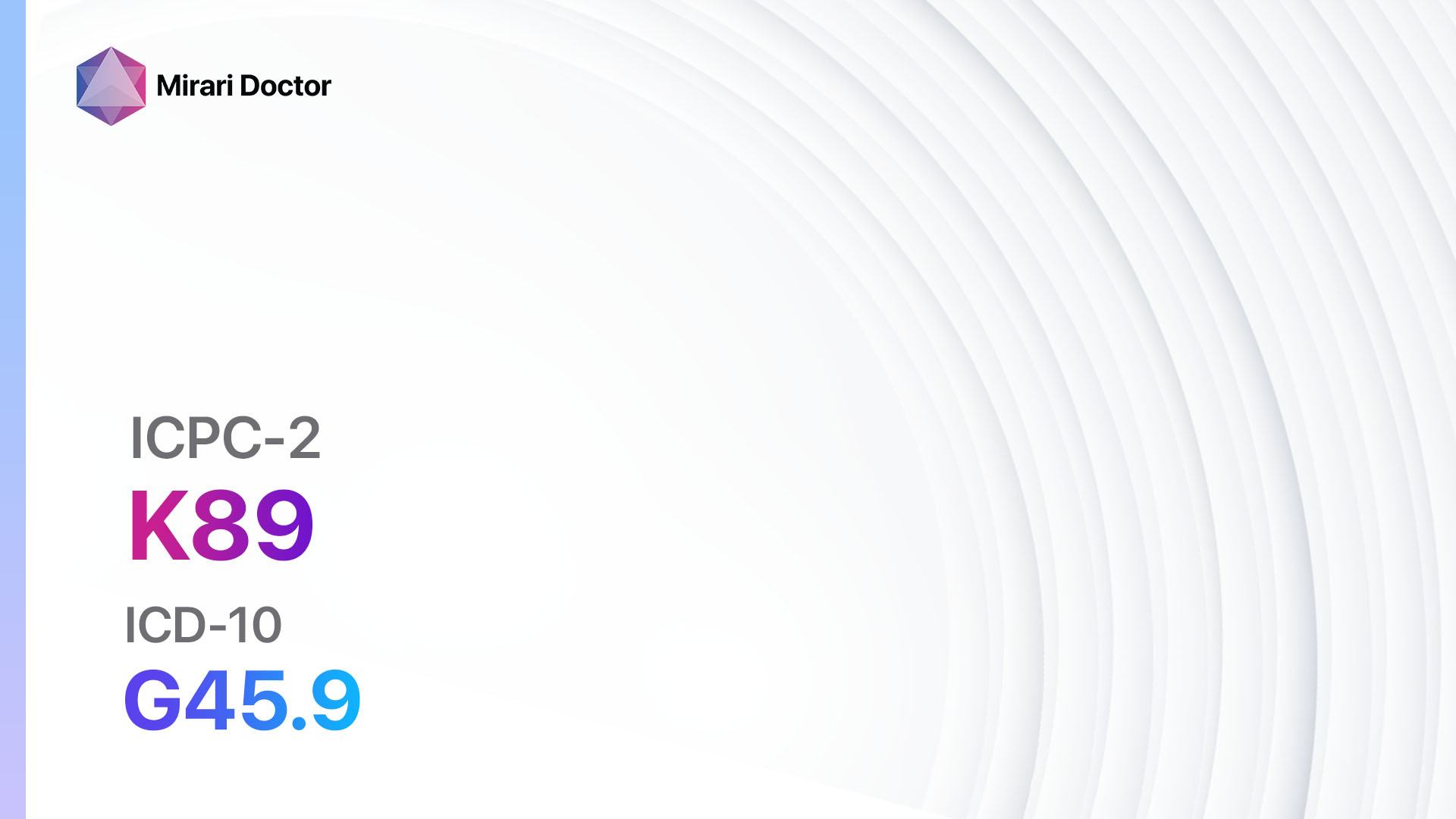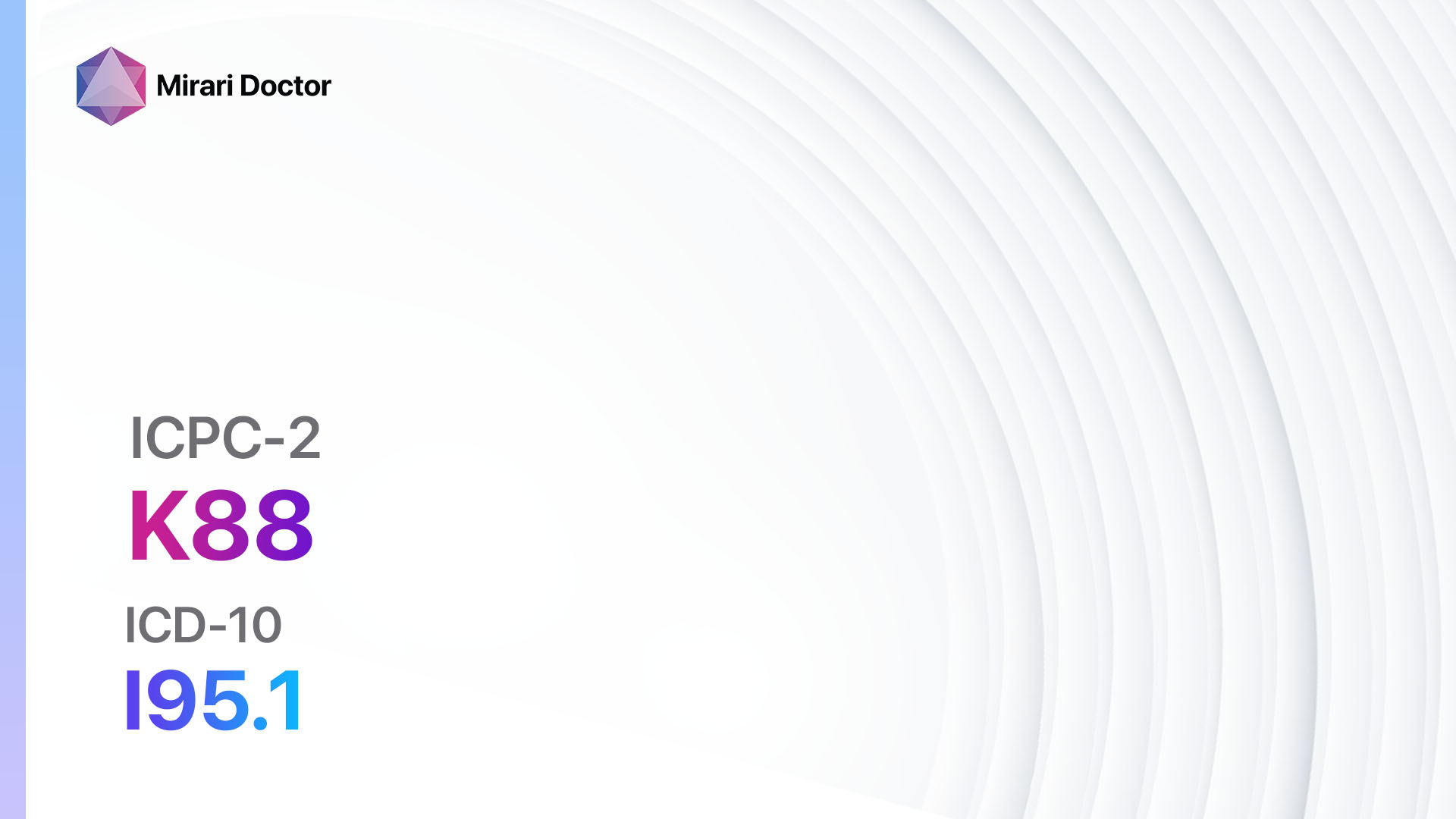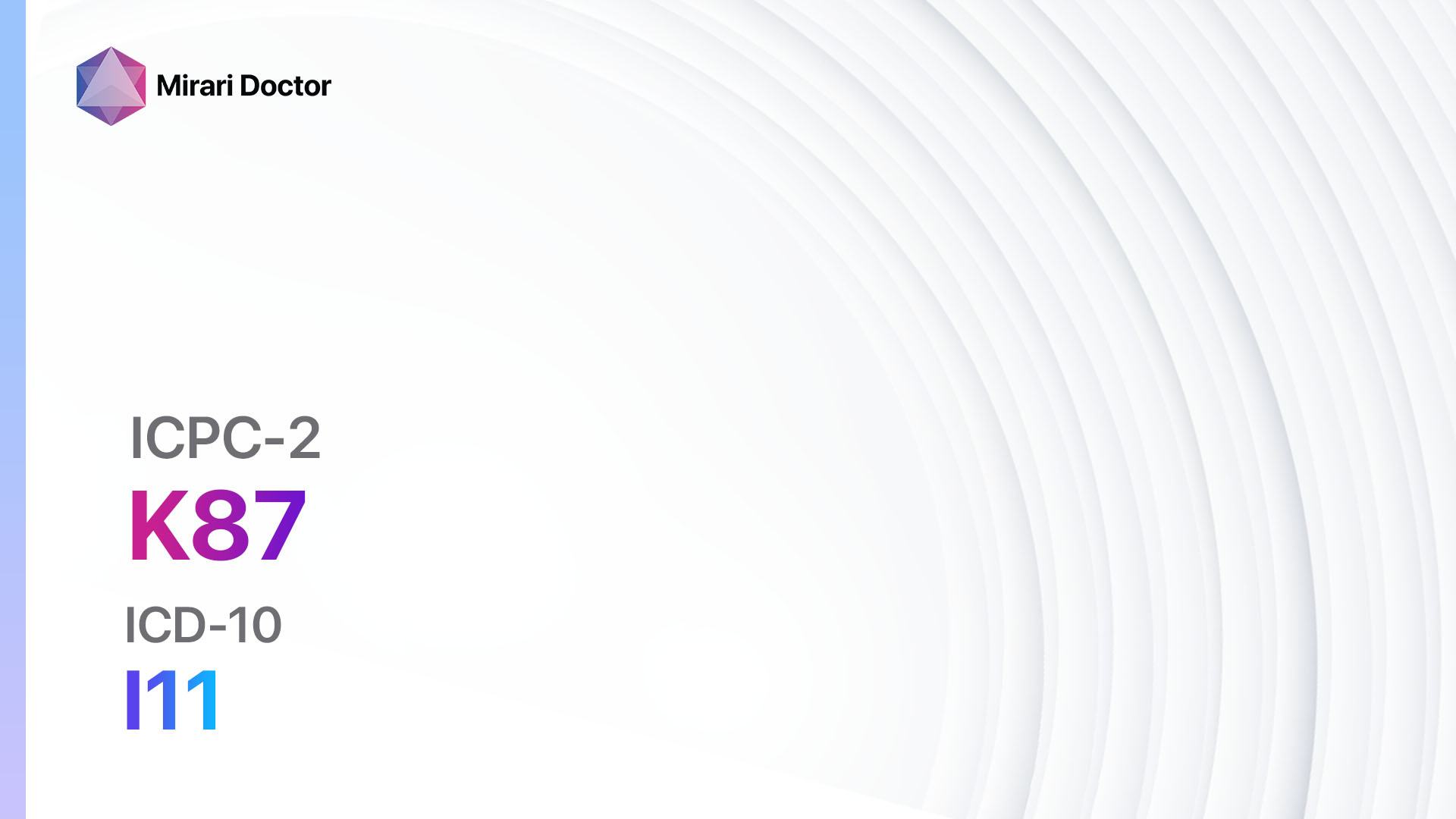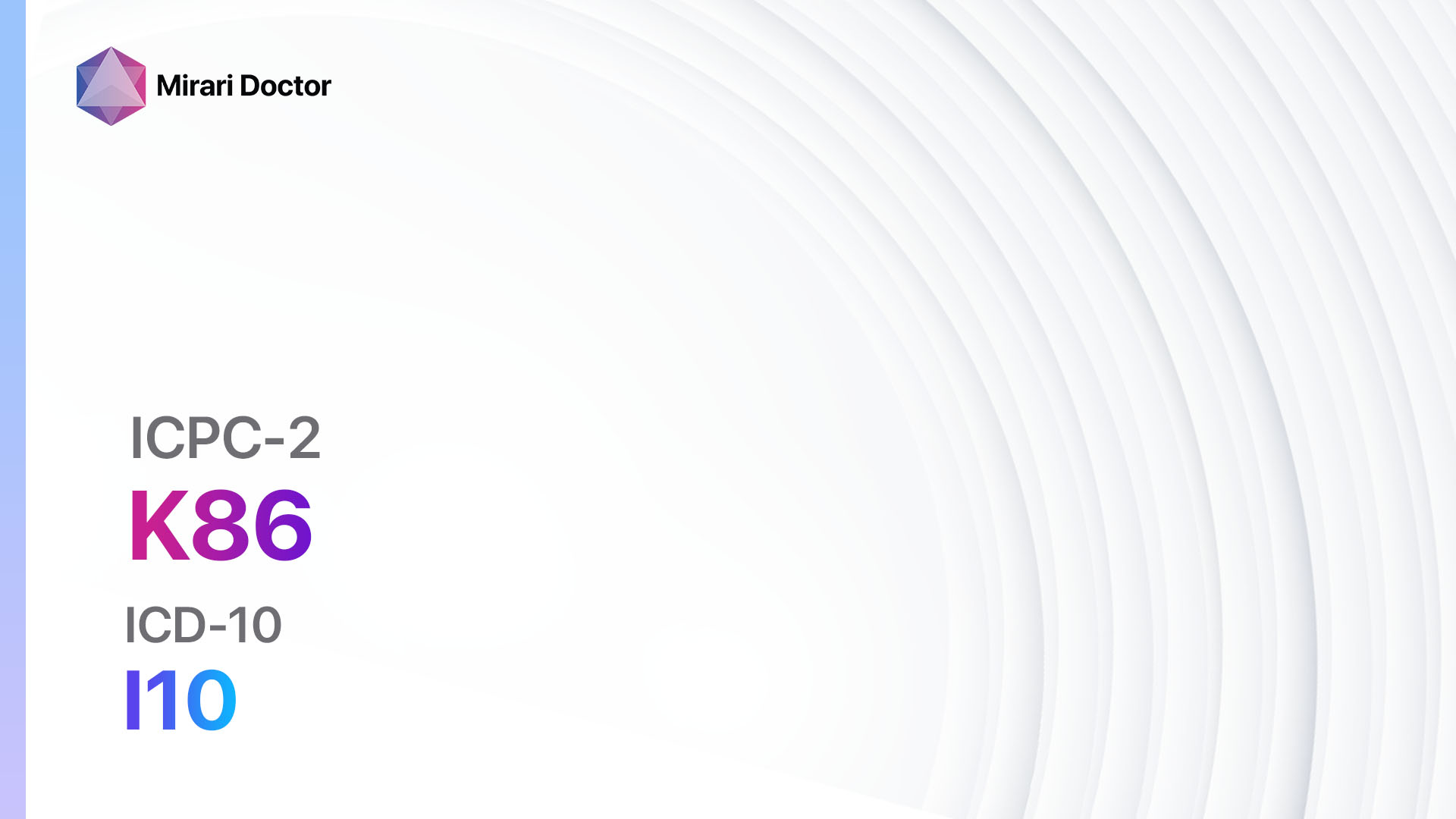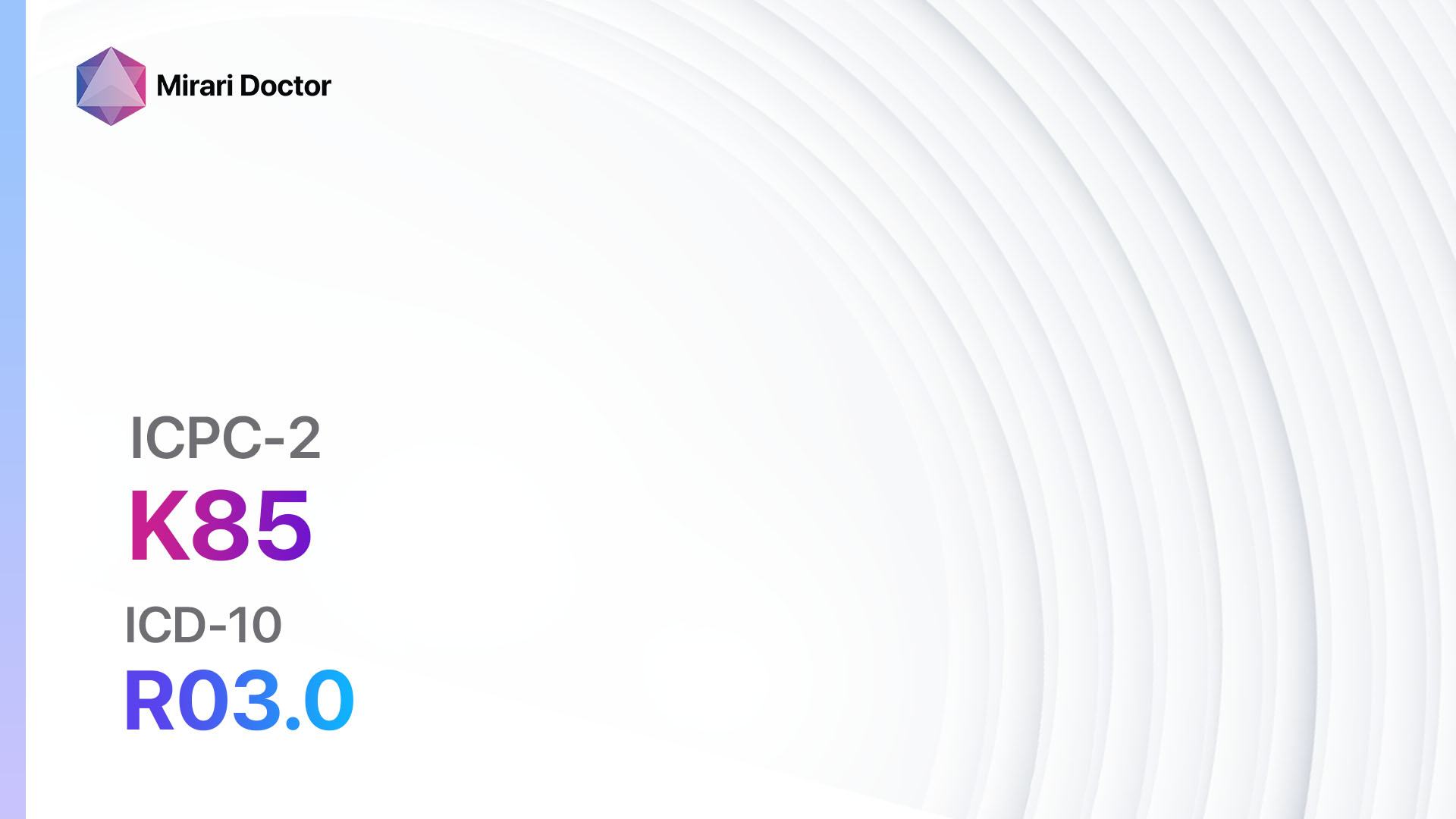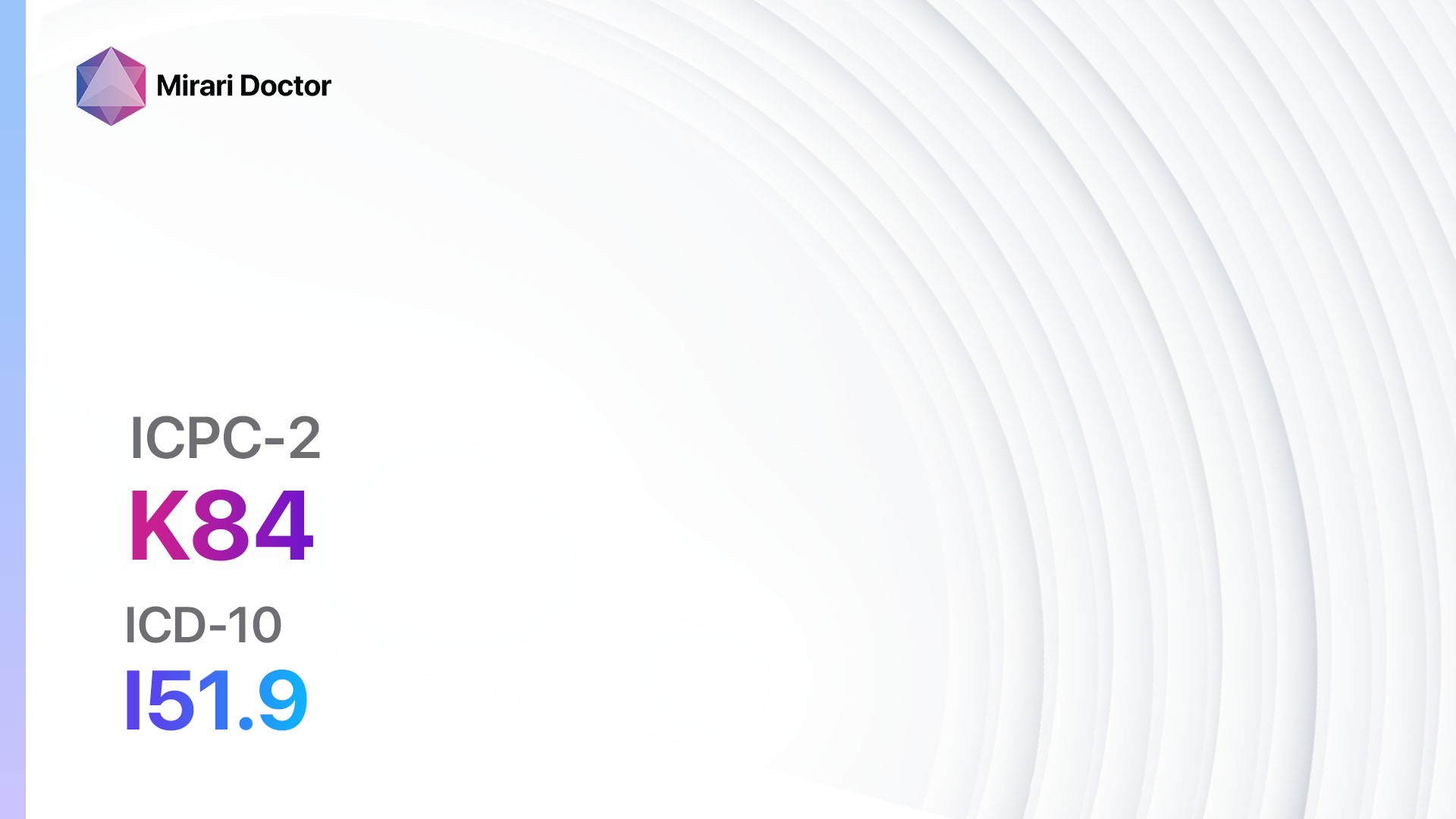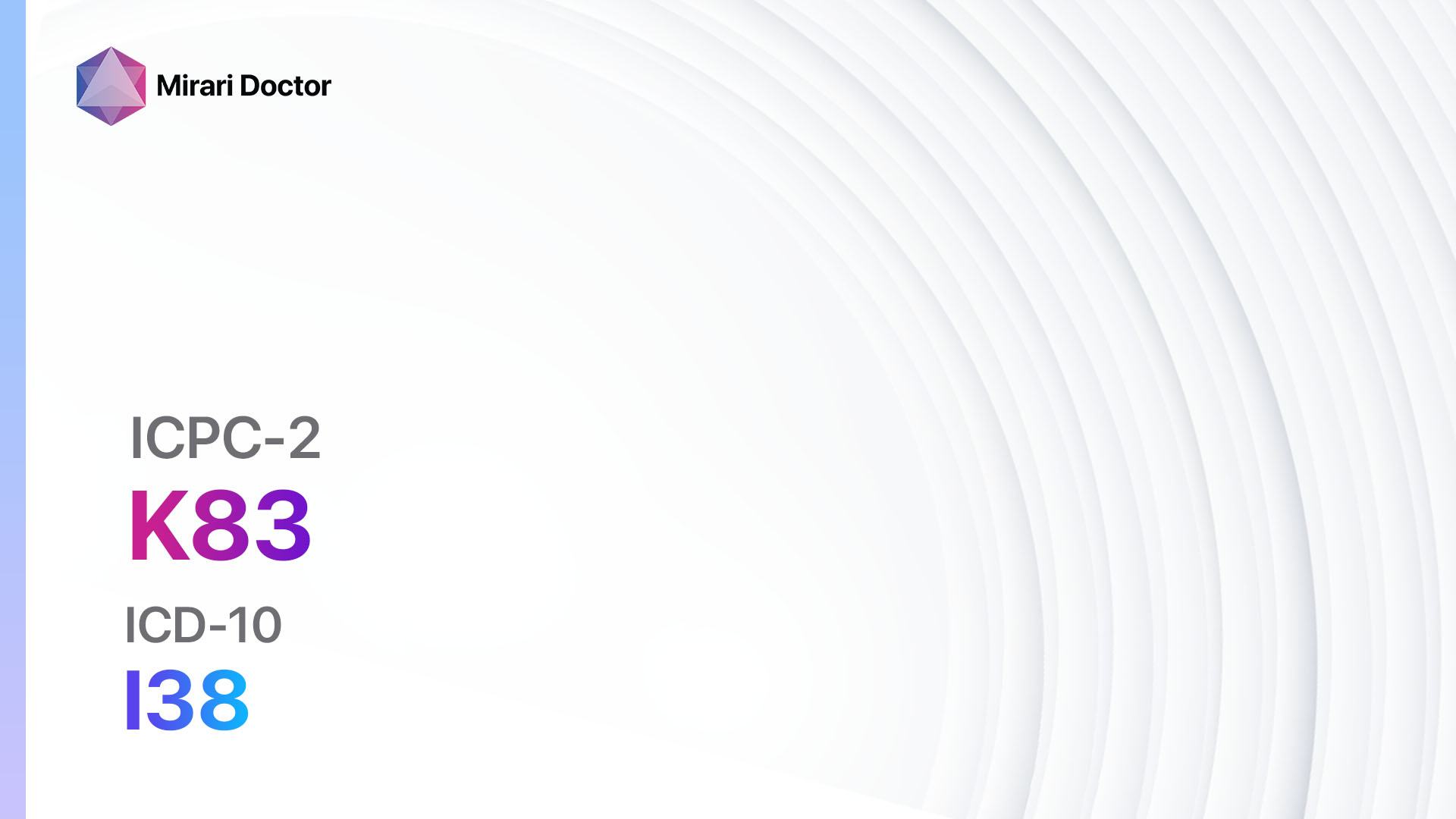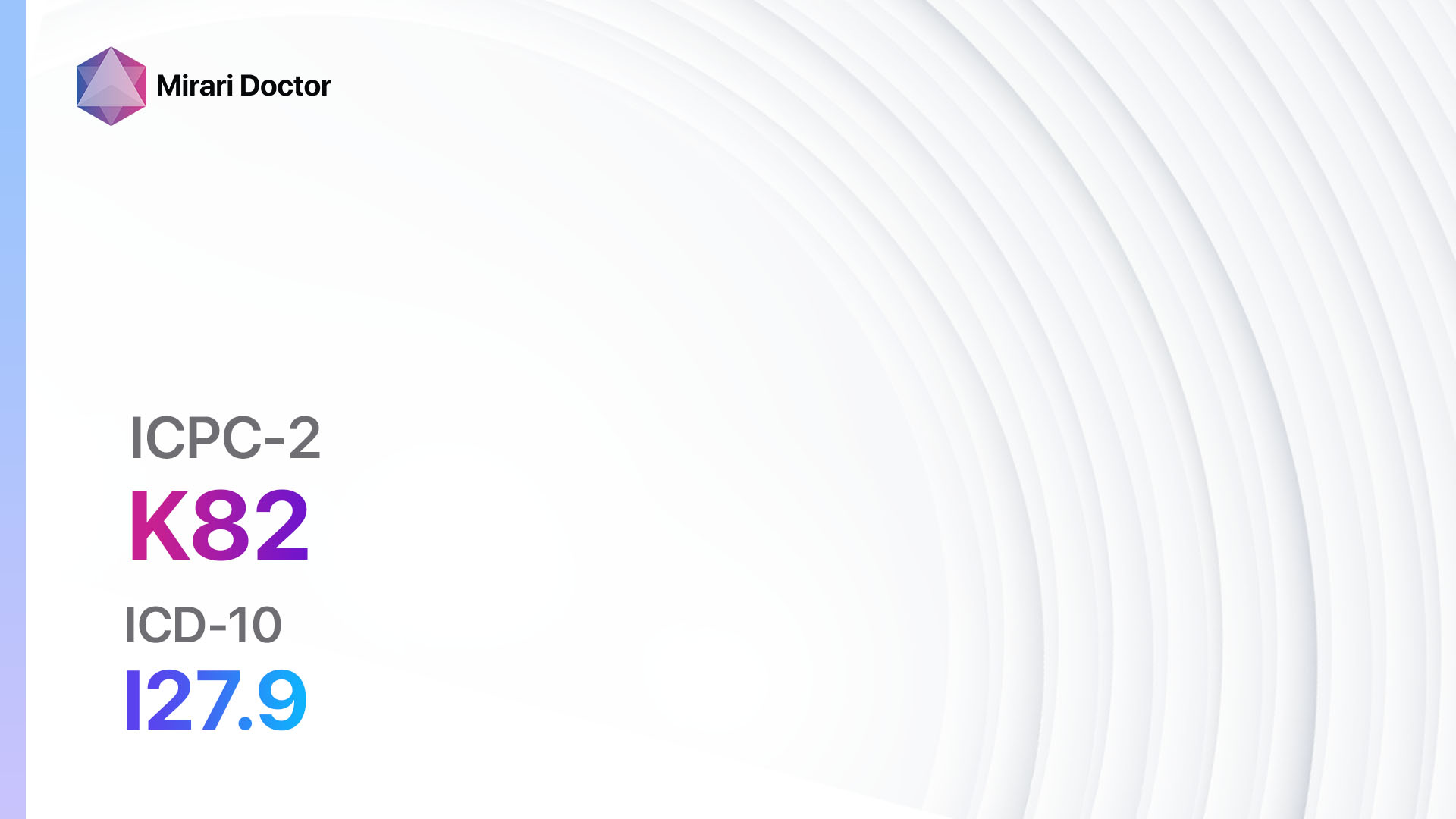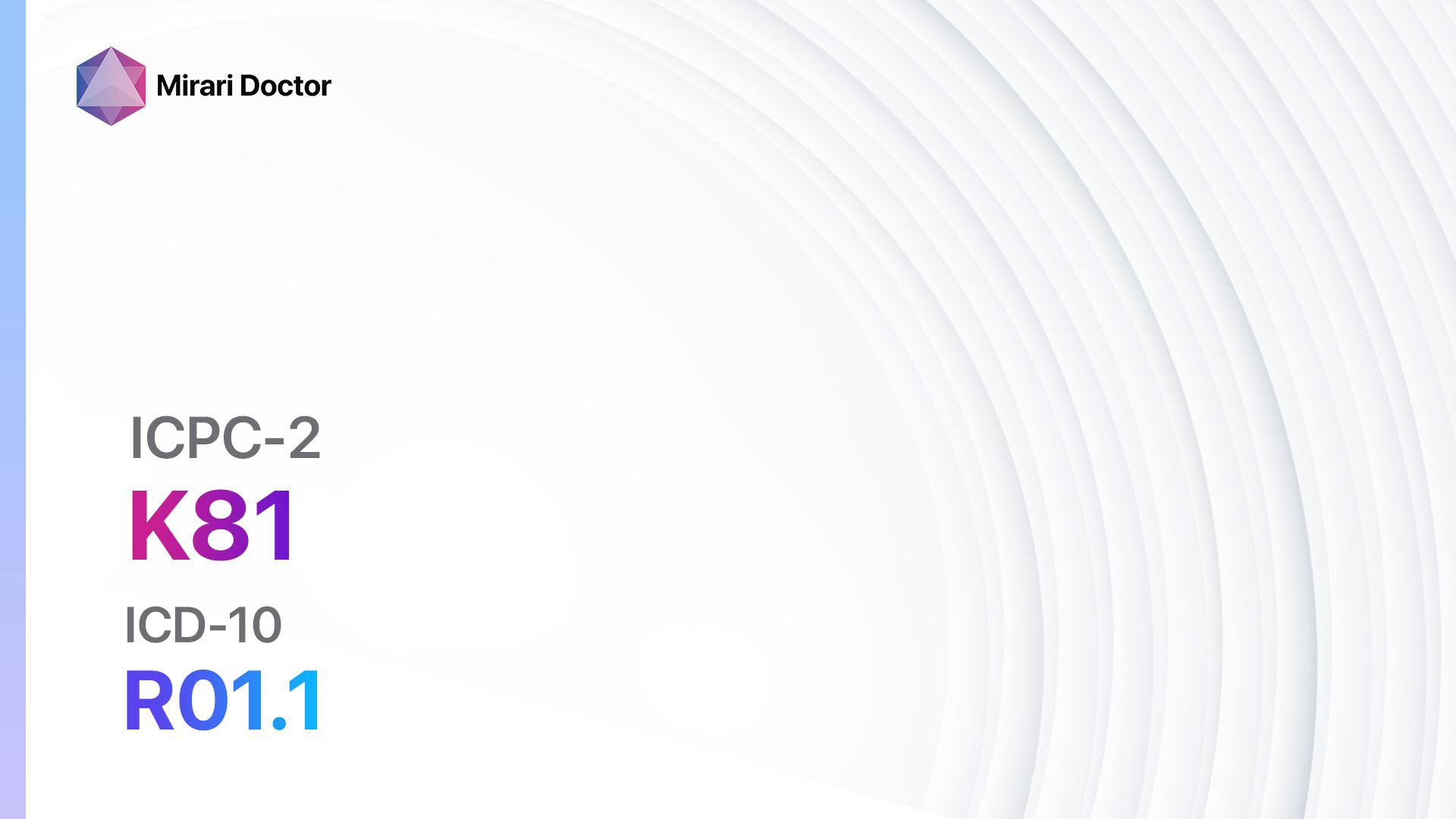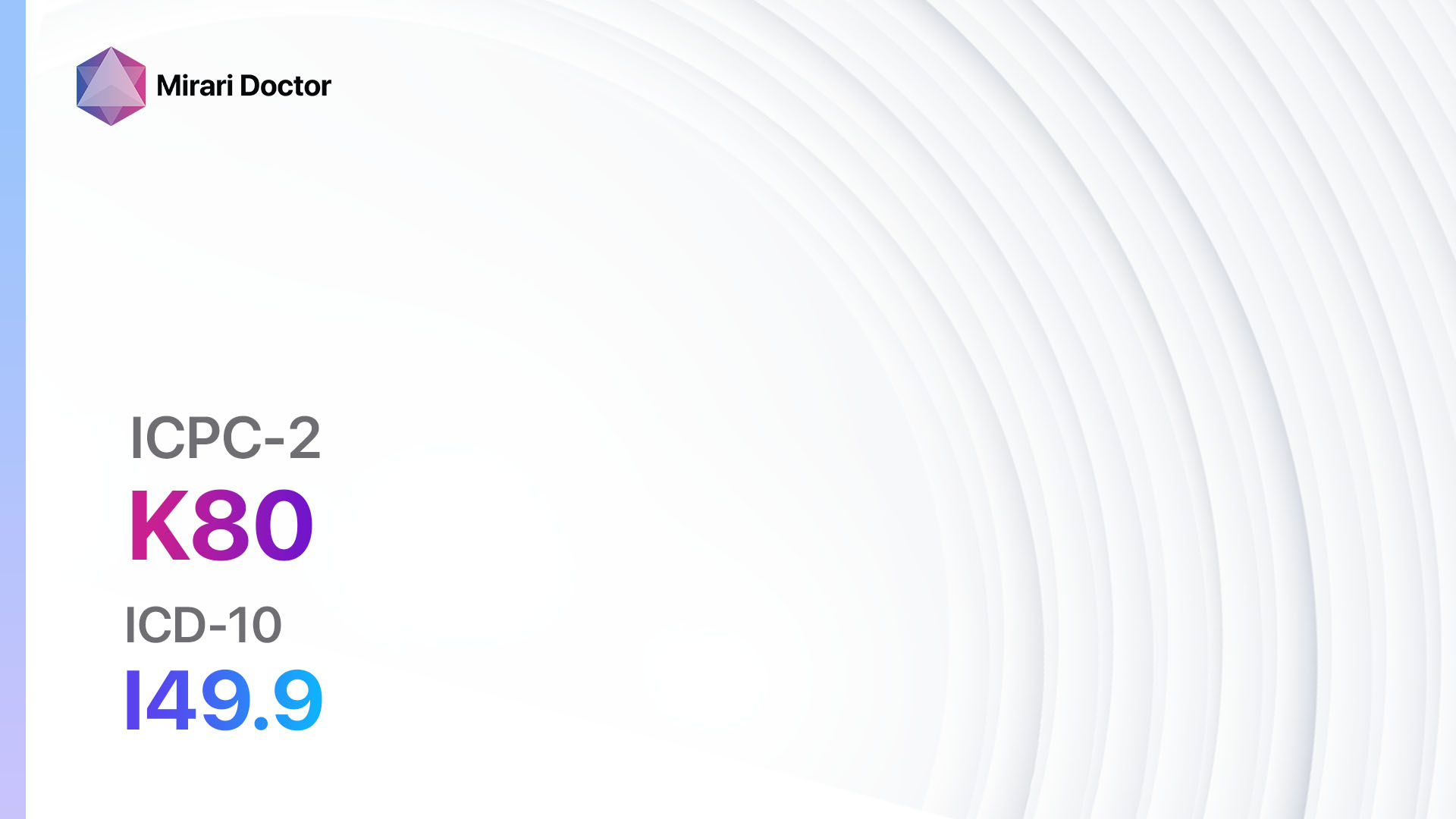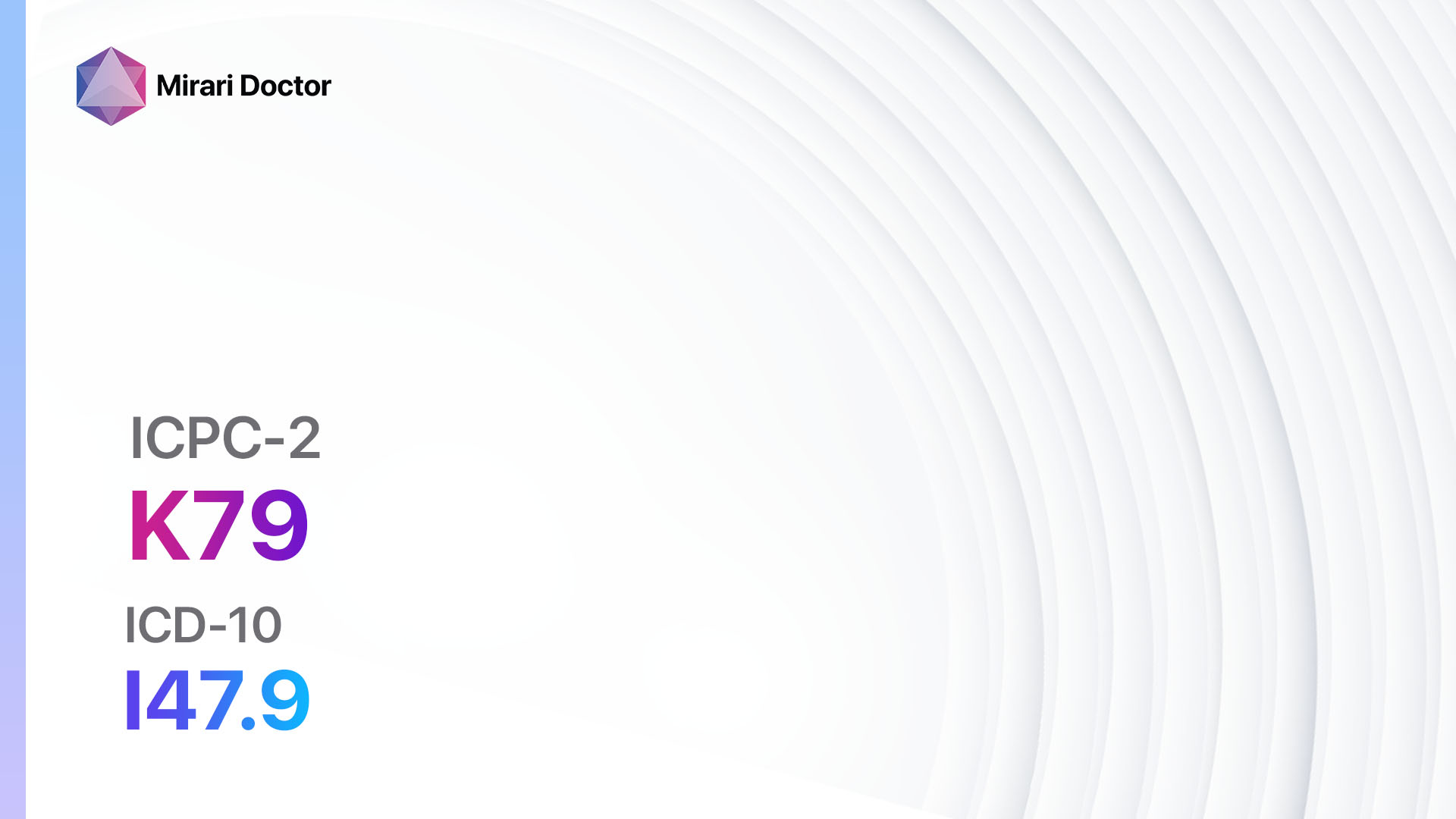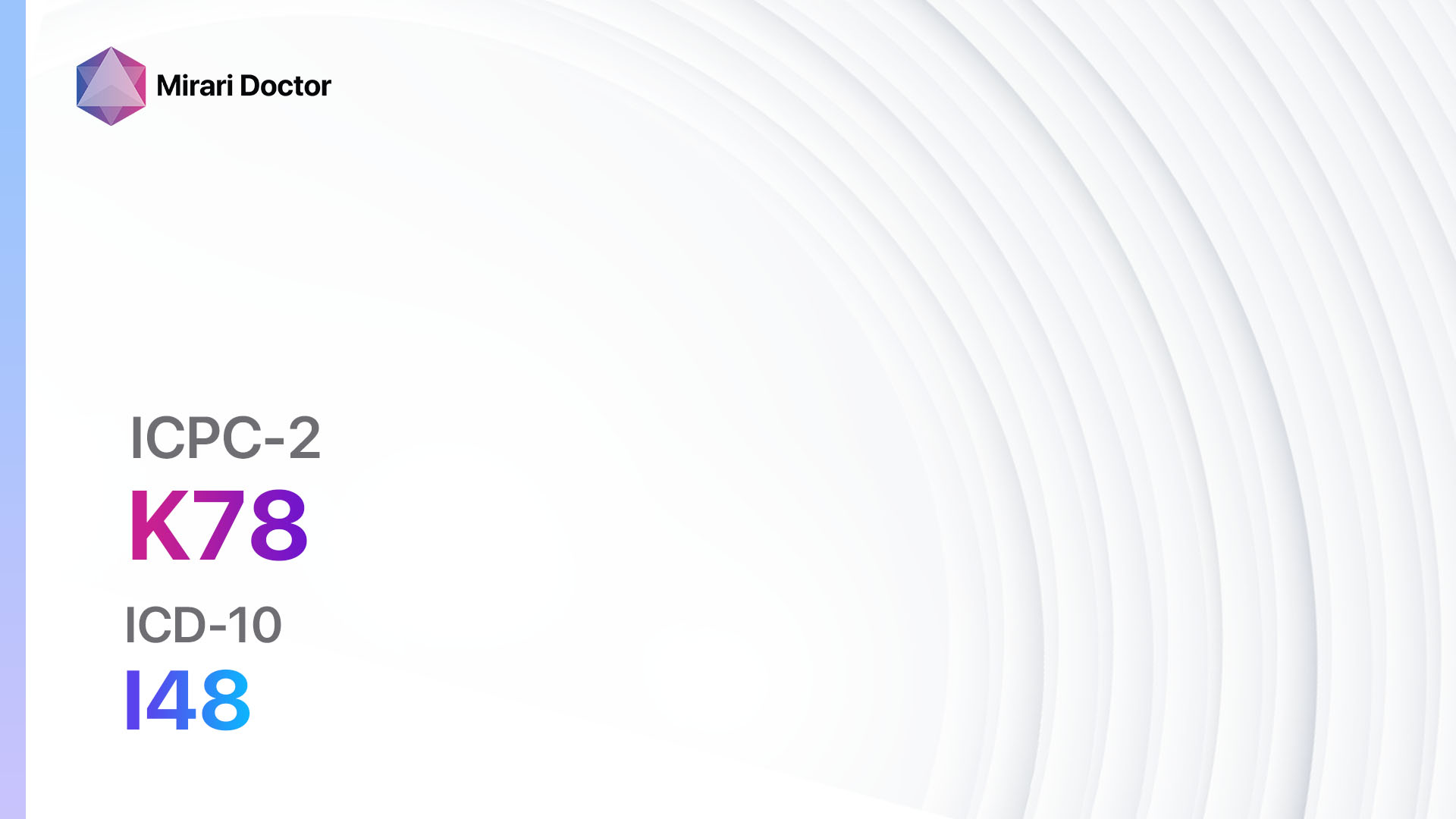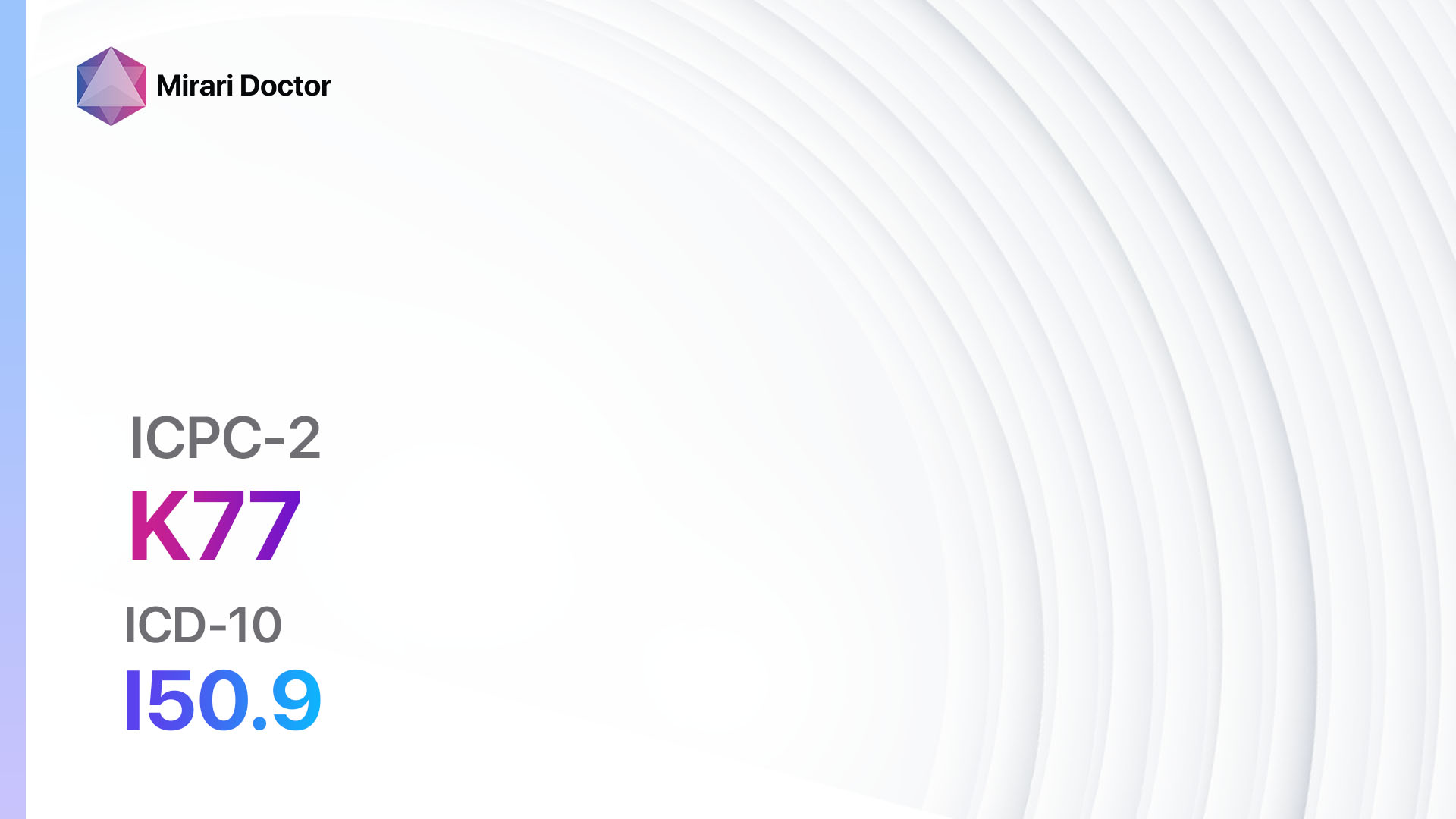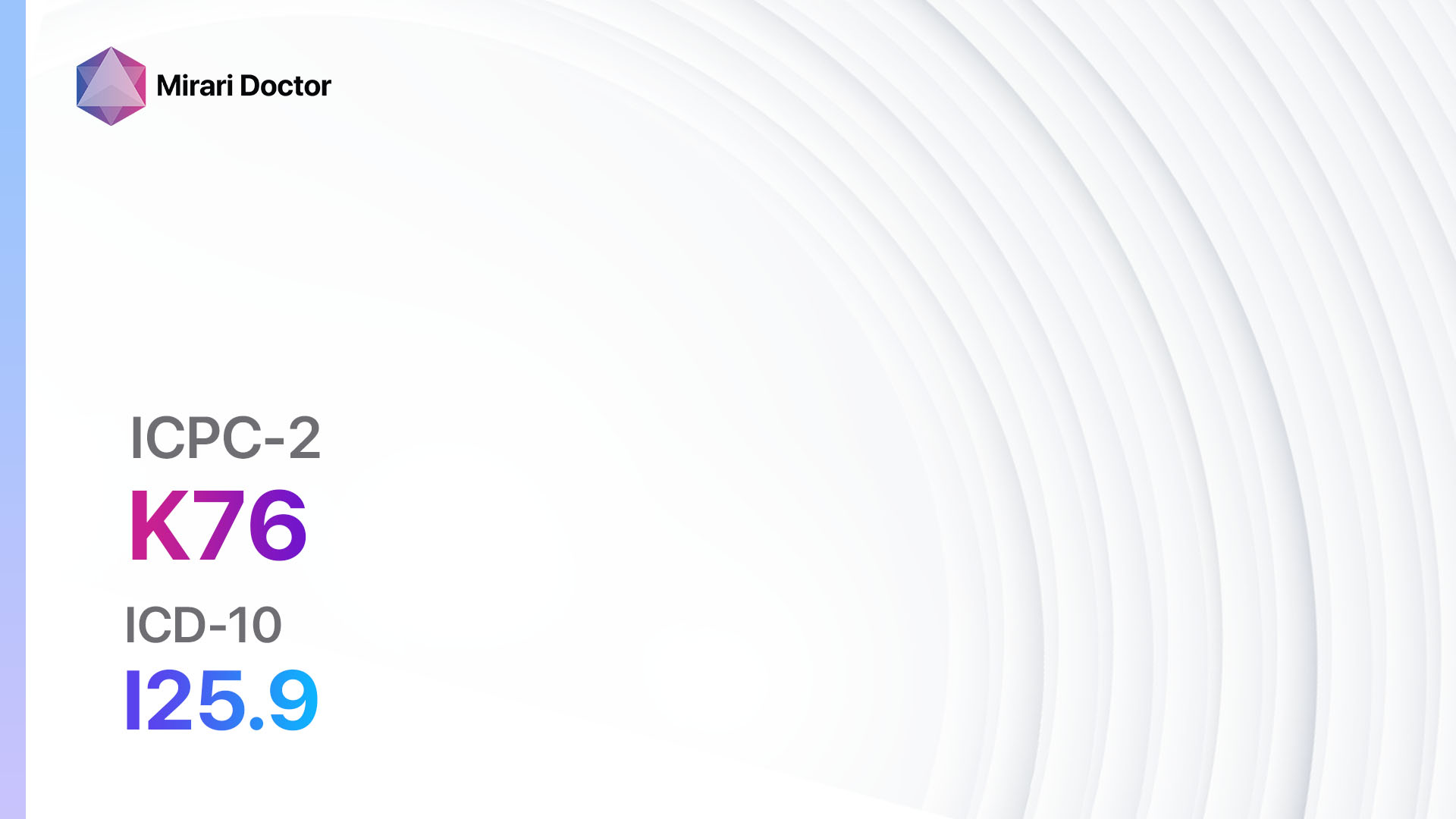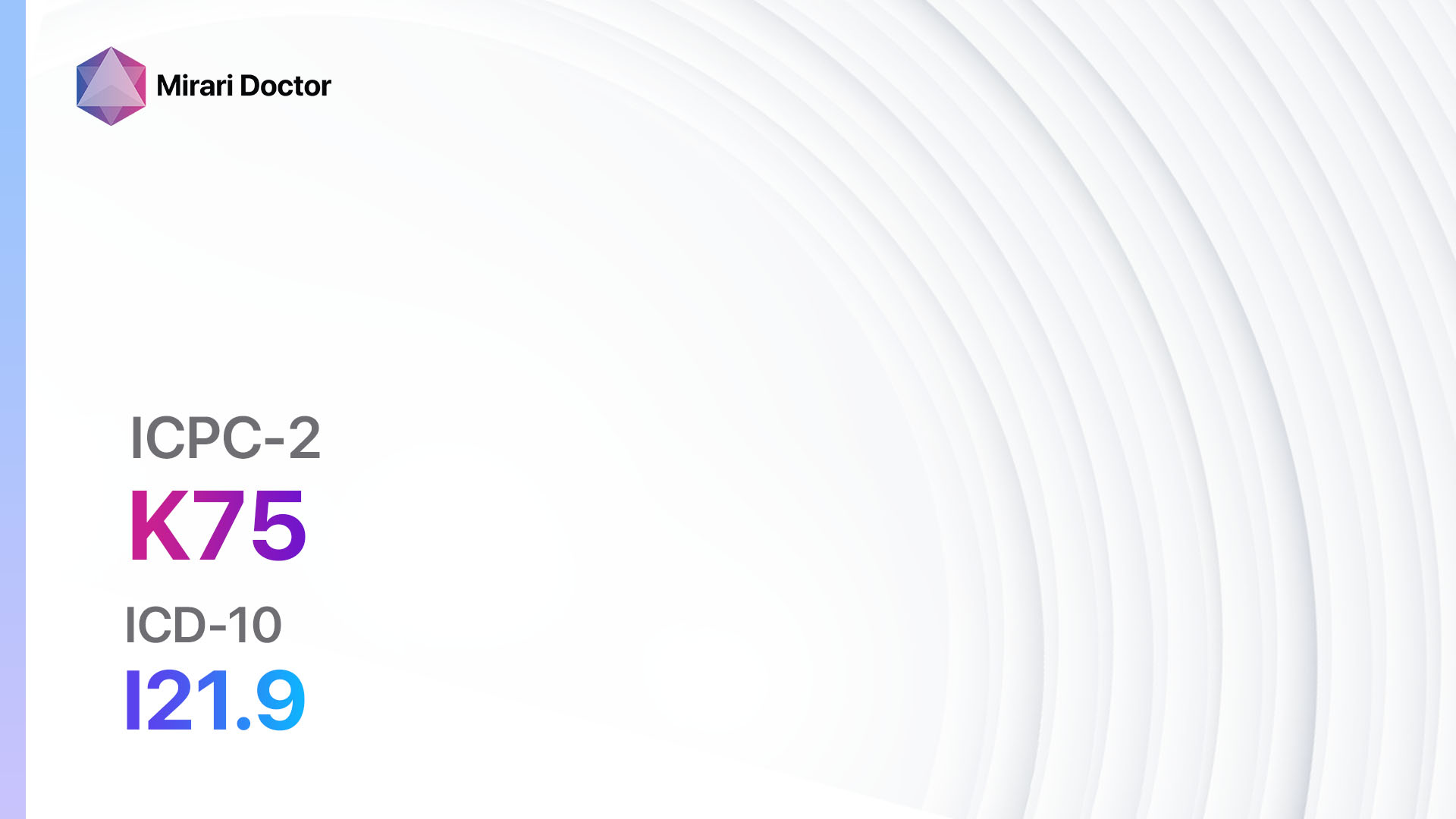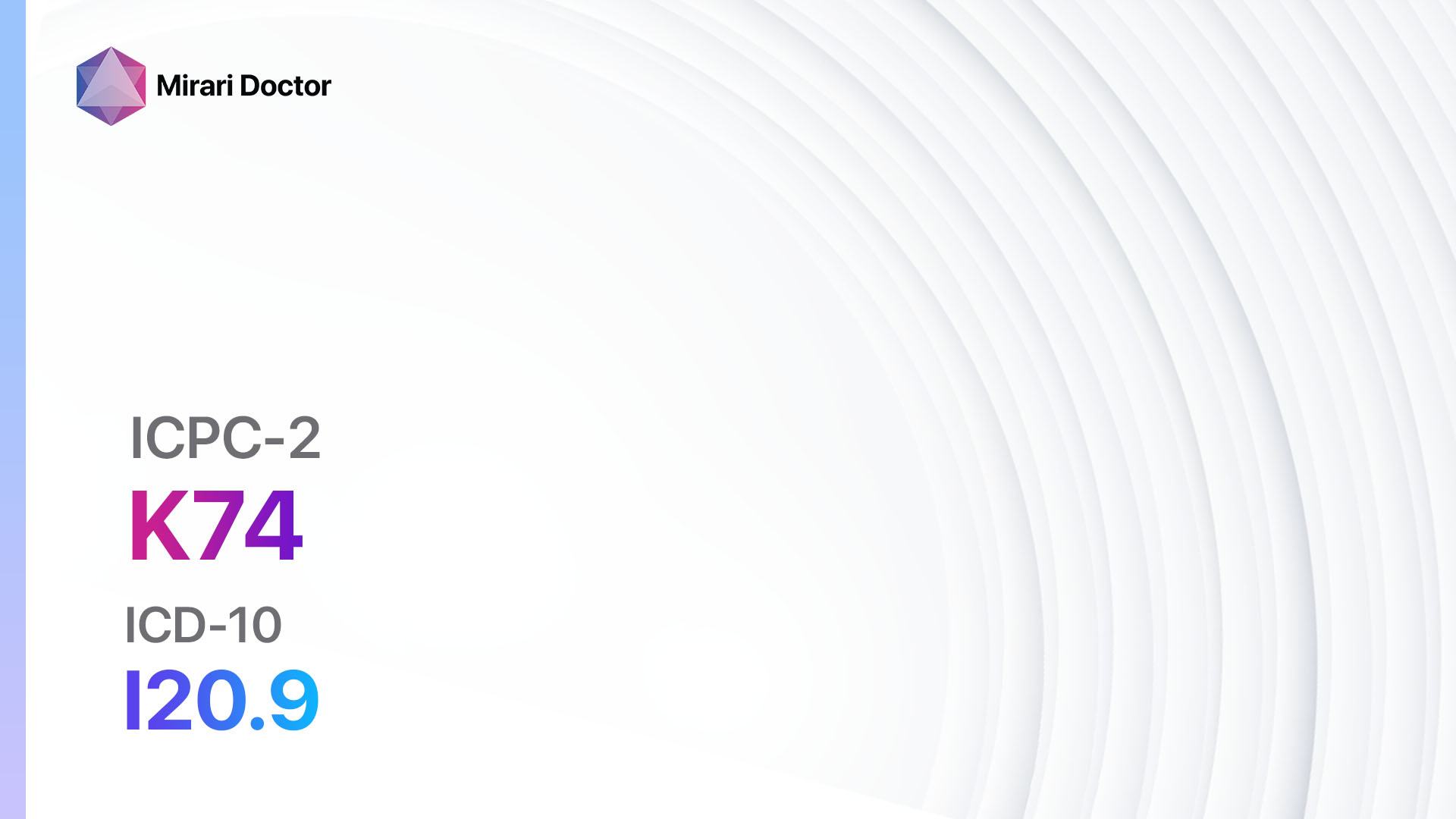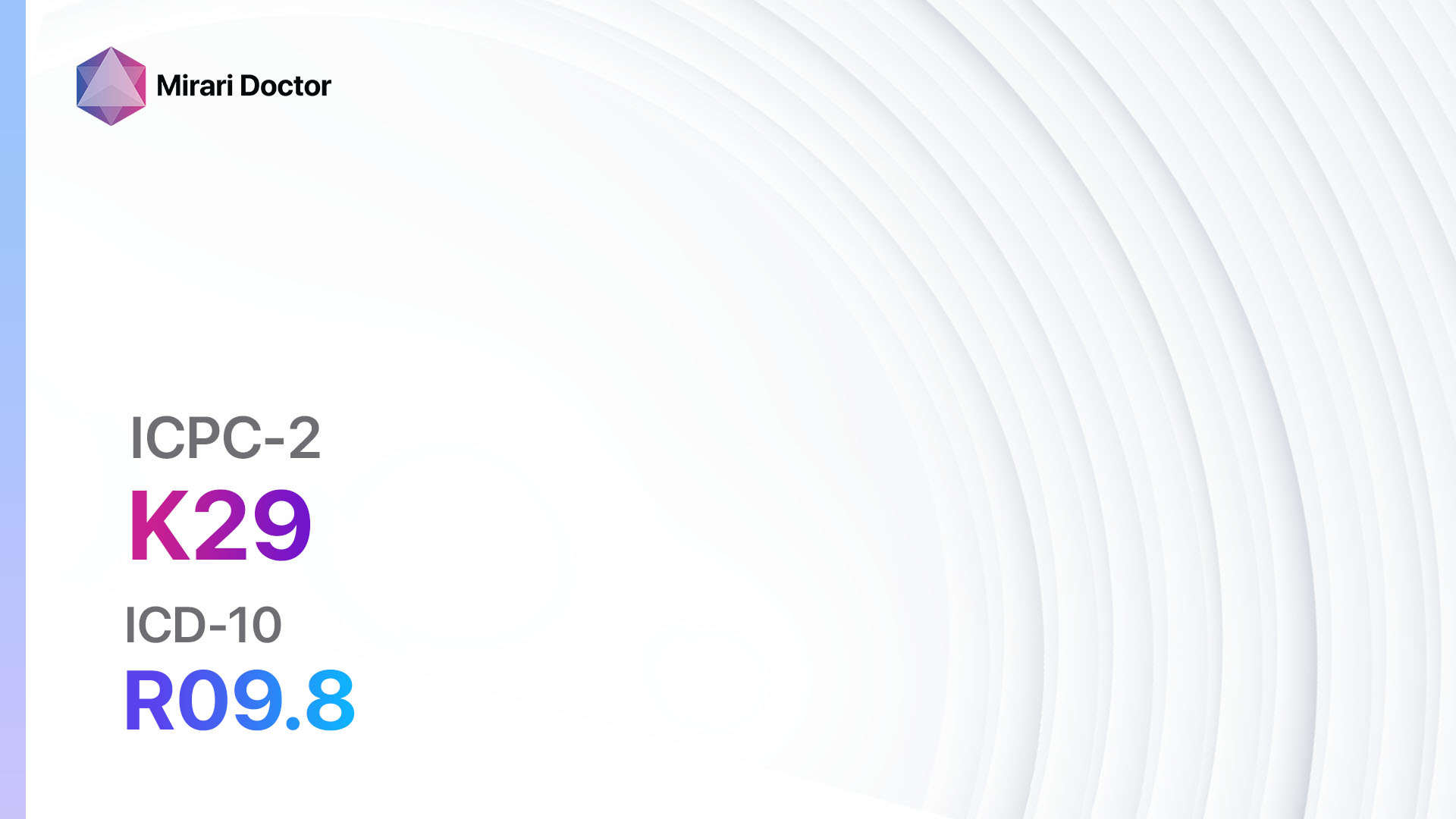
Introduction
Cardiovascular symptoms and complaints are common and can be indicative of various underlying conditions. This guide aims to provide an overview of the diagnostic steps and possible interventions for cardiovascular symptoms and complaints.
Codes
- ICPC-2 Code: K29 Cardiovascular sympt./complt. other
- ICD-10 Code: R09.8 Other specified symptoms and signs involving the circulatory and respiratory systems
Symptoms
- Chest pain: This can range from mild discomfort to severe pain and may be described as pressure, squeezing, or burning.[1]
- Shortness of breath: Difficulty breathing or feeling breathless, especially with exertion.[2]
- Palpitations: Sensation of a rapid or irregular heartbeat.[3]
- Fatigue: Feeling tired or lacking energy.[4]
- Dizziness or lightheadedness: Feeling faint or unsteady.[5]
- Swelling: Edema in the legs, ankles, or feet.[6]
- Cyanosis: Bluish discoloration of the lips, fingers, or toes.[7]
Causes
- Coronary artery disease: Narrowing or blockage of the arteries that supply blood to the heart.[8]
- Heart failure: Inability of the heart to pump blood effectively.[9]
- Arrhythmias: Abnormal heart rhythms.[10]
- Valvular heart disease: Malfunctioning or damaged heart valves.
- Pericarditis: Inflammation of the sac surrounding the heart.
- Cardiomyopathy: Disease of the heart muscle.
- Pulmonary embolism: Blockage of a blood vessel in the lungs.
- Hypertension: High blood pressure.
- Aortic dissection: Tear in the inner layer of the aorta.
Diagnostic Steps
Medical History
- Gather information about the patient’s symptoms, including their duration, severity, and any triggering factors.
- Assess the patient’s medical history, including any previous cardiovascular conditions, surgeries, or interventions.
- Identify risk factors such as smoking, obesity, sedentary lifestyle, family history of cardiovascular disease, and comorbidities like diabetes or hypertension.
Physical Examination
- Measure blood pressure, heart rate, and respiratory rate.
- Auscultate the heart and lungs for abnormal sounds.
- Palpate the peripheral pulses and check for edema.
- Examine the extremities for signs of cyanosis or clubbing.
- Assess the patient’s general appearance, including signs of distress or fatigue.
Laboratory Tests
- Complete blood count (CBC): To assess for anemia or infection.
- Lipid profile: To evaluate cholesterol and triglyceride levels.
- Cardiac biomarkers (troponin, CK-MB): To detect myocardial damage.
- Electrolyte panel: To assess for imbalances that may affect cardiac function.
- Liver function tests: To evaluate liver health and assess for potential drug interactions.
- Thyroid function tests: To rule out thyroid disorders that may contribute to cardiovascular symptoms.
Diagnostic Imaging
- Electrocardiogram (ECG): To assess the electrical activity of the heart and detect arrhythmias or ischemic changes.
- Echocardiogram: To evaluate the structure and function of the heart, including the valves and chambers.
- Chest X-ray: To assess the size and shape of the heart and detect any signs of pulmonary congestion or fluid accumulation.
- Stress test: To evaluate the heart’s response to exercise and assess for ischemia or arrhythmias.
- Cardiac CT or MRI: To obtain detailed images of the heart and blood vessels, useful for assessing coronary artery disease or structural abnormalities.
Other Tests
- Holter monitor: A portable device that records the heart’s electrical activity over a period of 24-48 hours, useful for detecting arrhythmias.
- Cardiac catheterization: Invasive procedure to visualize the coronary arteries and measure pressures within the heart.
- Transesophageal echocardiogram (TEE): A specialized echocardiogram performed by inserting a probe into the esophagus to obtain clearer images of the heart.
- Pulmonary function tests: To assess lung function and rule out respiratory causes of symptoms.
- Genetic testing: In certain cases, genetic testing may be indicated to identify inherited cardiovascular conditions.
Follow-up and Patient Education
- Schedule follow-up appointments to monitor the patient’s progress and adjust treatment as necessary.
- Provide education on lifestyle modifications, including diet, exercise, smoking cessation, and stress management.
- Discuss the importance of medication adherence and potential side effects.
- Address any concerns or questions the patient may have.
Possible Interventions
Traditional Interventions
Medications:
Top 5 drugs for Cardiovascular sympt./complt. other:
- Antiplatelet agents (e.g., Clopidogrel, Aspirin):
- Cost: Aspirin is inexpensive (<$10/month). Clopidogrel is $10-$100/month for generic.
- Contraindications: Active bleeding, peptic ulcer disease.
- Side effects: Upset stomach, bleeding.
- Severe side effects: Severe bleeding, allergic reactions.
- Drug interactions: NSAIDs, other blood thinners.
- Warning: Risk of bleeding.
- Beta-blockers (e.g., Metoprolol, Atenolol):
- Cost: Generic versions are typically <$30/month.
- Contraindications: Severe bradycardia, uncontrolled heart failure.
- Side effects: Fatigue, dizziness, bradycardia.
- Severe side effects: Bronchospasm, heart block.
- Drug interactions: Calcium channel blockers, insulin.
- Warning: Should not be abruptly stopped.
- ACE inhibitors (e.g., Ramipril, Lisinopril):
- Cost: Generics can be $10-$50/month.
- Contraindications: History of angioedema with ACE inhibitors, renal artery stenosis.
- Side effects: Cough, elevated blood urea nitrogen.
- Severe side effects: Angioedema, hyperkalemia.
- Drug interactions: Potassium supplements, NSAIDs.
- Warning: Monitoring of renal function and potassium is required.
- Calcium channel blockers (e.g., Amlodipine, Diltiazem):
- Cost: Generic versions can be $10-$50/month.
- Contraindications: Severe hypotension, heart failure.
- Side effects: Edema, dizziness, flushing.
- Severe side effects: Heart block, exacerbation of heart failure.
- Drug interactions: Grapefruit juice, beta-blockers.
- Warning: Monitoring of blood pressure and heart rate is required.
- Diuretics (e.g., Hydrochlorothiazide, Furosemide):
- Cost: Generic versions can be <$10/month.
- Contraindications: Severe electrolyte imbalance, anuria.
- Side effects: Frequent urination, electrolyte imbalances.
- Severe side effects: Hypotension, renal failure.
- Drug interactions: NSAIDs, lithium.
- Warning: Monitoring of electrolytes and renal function is required.
Alternative Drugs:
- Angiotensin receptor blockers (e.g., Losartan, Valsartan): Alternative to ACE inhibitors for patients who cannot tolerate them.
- Nitrates (e.g., Nitroglycerin): Used for the relief of angina symptoms.
- Digitalis (e.g., Digoxin): Used in certain cases of heart failure to improve cardiac function.
- Antiarrhythmics (e.g., Amiodarone, Flecainide): Used to control abnormal heart rhythms.
- Anticoagulants (e.g., Warfarin, Apixaban): Used to prevent blood clots in certain cardiovascular conditions.
Surgical Procedures:
- Angioplasty and stent placement: A catheter is used to place a stent to open up narrowed arteries. Cost: $15,000 to $50,000.
- Coronary artery bypass surgery (CABG): Redirects blood around blocked or narrowed coronary arteries. Cost: $70,000 to $200,000.
Alternative Interventions
- Acupuncture: May help improve blood flow and reduce pain. Cost: $60-$120 per session.
- Chelation therapy: Controversial treatment involving the administration of chelating agents to remove heavy metals from the body. Cost: $75-$150 per session.
- Hyperbaric oxygen therapy: Involves breathing pure oxygen in a pressurized chamber to increase oxygen delivery to tissues. Cost: $200-$300 per session.
- Herbal supplements: Some herbs, such as garlic and ginkgo biloba, may have potential benefits for improving circulation. Cost: Varies depending on the specific supplement.
Lifestyle Interventions
- Regular exercise: Engaging in aerobic exercise for at least 150 minutes per week can improve cardiovascular health. Cost: Varies depending on the chosen activity (e.g., gym membership, equipment).
- Healthy diet: Following a balanced diet rich in fruits, vegetables, whole grains, lean proteins, and healthy fats can help manage cardiovascular symptoms. Cost: Varies depending on food choices and dietary restrictions.
- Smoking cessation: Quitting smoking can significantly reduce the risk of cardiovascular complications. Cost: Varies depending on the chosen smoking cessation method (e.g., nicotine replacement therapy, medications, counseling).
- Stress management: Techniques such as meditation, yoga, and deep breathing exercises can help reduce stress and improve cardiovascular health. Cost: Varies depending on the chosen method (e.g., self-guided, classes, therapy).
- Weight management: Achieving and maintaining a healthy weight can reduce the strain on the cardiovascular system. Cost: Varies depending on the chosen weight loss method (e.g., diet programs, gym membership, personal trainer).
It is important to note that the cost ranges provided are approximate and may vary depending on the location and availability of the interventions.
Mirari Cold Plasma Alternative Intervention
Understanding Mirari Cold Plasma
- Safe and Non-Invasive Treatment: Mirari Cold Plasma is a safe and non-invasive treatment option for various skin conditions. It does not require incisions, minimizing the risk of scarring, bleeding, or tissue damage.
- Efficient Extraction of Foreign Bodies: Mirari Cold Plasma facilitates the removal of foreign bodies from the skin by degrading and dissociating organic matter, allowing easier access and extraction.
- Pain Reduction and Comfort: Mirari Cold Plasma has a local analgesic effect, providing pain relief during the treatment, making it more comfortable for the patient.
- Reduced Risk of Infection: Mirari Cold Plasma has antimicrobial properties, effectively killing bacteria and reducing the risk of infection.
- Accelerated Healing and Minimal Scarring: Mirari Cold Plasma stimulates wound healing and tissue regeneration, reducing healing time and minimizing the formation of scars.
Mirari Cold Plasma Prescription
Video instructions for using Mirari Cold Plasma Device – K29 Cardiovascular sympt./complt. other (ICD-10:R09.8)
| Mild | Moderate | Severe |
| Mode setting: 1 (Infection) Location: 5 (Lungs) Morning: 15 minutes, Evening: 15 minutes |
Mode setting: 1 (Infection) Location: 5 (Lungs) Morning: 30 minutes, Lunch: 30 minutes, Evening: 30 minutes |
Mode setting: 1 (Infection) Location: 5 (Lungs) Morning: 30 minutes, Lunch: 30 minutes, Evening: 30 minutes |
| Mode setting: 2 (Wound Healing) Location: 5 (Lungs) Morning: 15 minutes, Evening: 15 minutes |
Mode setting: 2 (Wound Healing) Location: 5 (Lungs) Morning: 30 minutes, Lunch: 30 minutes, Evening: 30 minutes |
Mode setting: 2 (Wound Healing) Location: 5 (Lungs) Morning: 30 minutes, Lunch: 30 minutes, Evening: 30 minutes |
| Mode setting: 7 (Immunotherapy) Location: 1 (Sacrum) Morning: 15 minutes, Evening: 15 minutes |
Mode setting: 7 (Immunotherapy) Location: 1 (Sacrum) Morning: 30 minutes, Lunch: 30 minutes, Evening: 30 minutes |
Mode setting: 7 (Immunotherapy) Location: 1 (Sacrum) Morning: 30 minutes, Lunch: 30 minutes, Evening: 30 minutes |
| Mode setting: 7 (Immunotherapy) Location: 4 (Heart, Bile & Pancreas) Morning: 15 minutes, Evening: 15 minutes |
Mode setting: 7 (Immunotherapy) Location: 4 (Heart, Bile & Pancreas) Morning: 30 minutes, Lunch: 30 minutes, Evening: 30 minutes |
Mode setting:7 (Immunotherapy) Location: 4 (Heart, Bile & Pancreas) Morning: 30 minutes, Lunch: 30 minutes, Evening: 30 minutes |
| Total Morning: 60 minutes approx. $10 USD, Evening: 60 minutes approx. $10 USD |
Total Morning: 120 minutes approx. $20 USD, Lunch: 120 minutes approx. $20 USD, Evening: 120 minutes approx. $20 USD, |
Total Morning: 120 minutes approx. $20 USD, Lunch: 120 minutes approx. $20 USD, Evening: 120 minutes approx. $20 USD, |
| Usual treatment for 7-60 days approx. $140 USD – $1200 USD | Usual treatment for 6-8 weeks approx. $2,520 USD – $3,360 USD |
Usual treatment for 3-6 months approx. $5,400 USD – $10,800 USD
|
 |
|
Use the Mirari Cold Plasma device to treat Cardiovascular sympt./complt. other effectively.
WARNING: MIRARI COLD PLASMA IS DESIGNED FOR THE HUMAN BODY WITHOUT ANY ARTIFICIAL OR THIRD PARTY PRODUCTS. USE OF OTHER PRODUCTS IN COMBINATION WITH MIRARI COLD PLASMA MAY CAUSE UNPREDICTABLE EFFECTS, HARM OR INJURY. PLEASE CONSULT A MEDICAL PROFESSIONAL BEFORE COMBINING ANY OTHER PRODUCTS WITH USE OF MIRARI.
Step 1: Cleanse the Skin
- Start by cleaning the affected area of the skin with a gentle cleanser or mild soap and water. Gently pat the area dry with a clean towel.
Step 2: Prepare the Mirari Cold Plasma device
- Ensure that the Mirari Cold Plasma device is fully charged or has fresh batteries as per the manufacturer’s instructions. Make sure the device is clean and in good working condition.
- Switch on the Mirari device using the power button or by following the specific instructions provided with the device.
- Some Mirari devices may have adjustable settings for intensity or treatment duration. Follow the manufacturer’s instructions to select the appropriate settings based on your needs and the recommended guidelines.
Step 3: Apply the Device
- Place the Mirari device in direct contact with the affected area of the skin. Gently glide or hold the device over the skin surface, ensuring even coverage of the area experiencing.
- Slowly move the Mirari device in a circular motion or follow a specific pattern as indicated in the user manual. This helps ensure thorough treatment coverage.
Step 4: Monitor and Assess:
- Keep track of your progress and evaluate the effectiveness of the Mirari device in managing your Cardiovascular sympt./complt. other. If you have any concerns or notice any adverse reactions, consult with your health care professional.
Note
This guide is for informational purposes only and should not replace the advice of a medical professional. Always consult with your healthcare provider or a qualified medical professional for personal advice, diagnosis, or treatment. Do not solely rely on the information presented here for decisions about your health. Use of this information is at your own risk. The authors of this guide, nor any associated entities or platforms, are not responsible for any potential adverse effects or outcomes based on the content.
Mirari Cold Plasma System Disclaimer
- Purpose: The Mirari Cold Plasma System is a Class 2 medical device designed for use by trained healthcare professionals. It is registered for use in Thailand and Vietnam. It is not intended for use outside of these locations.
- Informational Use: The content and information provided with the device are for educational and informational purposes only. They are not a substitute for professional medical advice or care.
- Variable Outcomes: While the device is approved for specific uses, individual outcomes can differ. We do not assert or guarantee specific medical outcomes.
- Consultation: Prior to utilizing the device or making decisions based on its content, it is essential to consult with a Certified Mirari Tele-Therapist and your medical healthcare provider regarding specific protocols.
- Liability: By using this device, users are acknowledging and accepting all potential risks. Neither the manufacturer nor the distributor will be held accountable for any adverse reactions, injuries, or damages stemming from its use.
- Geographical Availability: This device has received approval for designated purposes by the Thai and Vietnam FDA. As of now, outside of Thailand and Vietnam, the Mirari Cold Plasma System is not available for purchase or use.
References
- Ambrosetti, M., Abreu, A., Corrà, U., Davos, C. H., Hansen, D., Frederix, I., … & Piepoli, M. F. (2020). Secondary prevention through comprehensive cardiovascular rehabilitation: From knowledge to implementation. 2020 update. A position paper from the Secondary Prevention and Rehabilitation Section of the European Association of Preventive Cardiology. European Journal of Preventive Cardiology, 2047487320913379.
- Abreu, A., Schmid, J. P., Piepoli, M., & Ruivo, J. (2020). The ESC Handbook of Cardiovascular Rehabilitation. Oxford University Press.
- Grant, J., & Graven, L. (2018). Problems experienced by informal caregivers of individuals with heart failure: An integrative review. International Journal of Nursing Studies, 80, 41-66.
- Strang, S., Fährn, J., Strang, P., Ronstad, A., & Danielsson, L. (2019). Support to informal caregivers of patients with severe chronic obstructive pulmonary disease: A qualitative study of caregivers’ and professionals’ experiences in Swedish hospitals. BMJ Open, 9(8), e028720.
- World Health Organization. (2023). Cardiovascular Diseases. Retrieved from https://www.who.int/pt
- British Association for Cardiovascular Prevention and Rehabilitation. (2012). BACPR Standards and Core Components for Cardiovascular Disease Prevention and Rehabilitation (2nd ed.). UKBACPR. Retrieved from www.bacpr.com/rsources/46C_BACPR_Standards_and_Core_Components_2012.pdf
- Felner, J. M. (1990). An overview of the cardiovascular system. In H. K. Walker, W. D. Hall, & J. W. Hurst (Eds.), Clinical methods: The history, physical, and laboratory examinations (3rd ed., Chapter 7). Butterworths.
- Dakak, N., Quyyumi, A. A., Eisenhofer, G., Goldstein, D. S., & Cannon, R. O. (1995). Sympathetically mediated effects of mental stress on the cardiac microcirculation of patients with coronary artery disease. The American Journal of Cardiology, 76(2), 125-130.
- Digdon, N., & Koble, A. (2011). Effects of constructive worry, imagery distraction, and gratitude interventions on sleep quality: A pilot trial. Applied Psychology: Health and Well‐Being, 3(2), 193-206.
- Disabato, D. J., Kashdan, T. B., Short, J. L., & Jarden, A. (2017). What predicts positive life events that influence the course of depression? A longitudinal examination of gratitude and meaning in life. Cognitive Therapy and Research, 41(3), 444-458.
Related articles
Made in USA


